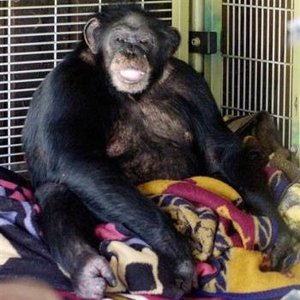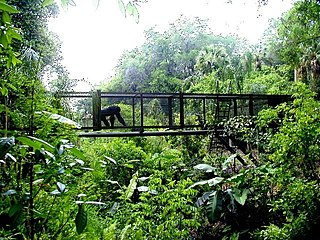Related Research Articles

The chimpanzee, or simply known as the chimp, is a species of great ape native to the forests and savannahs of tropical Africa. It has four confirmed subspecies and a fifth proposed one. When its close relative the bonobo was more commonly known as the pygmy chimpanzee, this species was often called the common chimpanzee or the robust chimpanzee. The chimpanzee and the bonobo are the only species in the genus Pan. Evidence from fossils and DNA sequencing shows that Pan is a sister taxon to the human lineage and is thus humans' closest living relative. The chimpanzee is covered in coarse black hair, but has a bare face, fingers, toes, palms of the hands, and soles of the feet. It is larger and more robust than the bonobo, weighing 40–70 kg (88–154 lb) for males and 27–50 kg (60–110 lb) for females and standing 150 cm.

Dame Jane Morris Goodall, formerly Baroness Jane van Lawick-Goodall, is an English primatologist and anthropologist. She is considered the world's foremost expert on chimpanzees, after 60 years' studying the social and family interactions of wild chimpanzees. Goodall first went to Gombe Stream National Park in Tanzania to observe its chimpanzees in 1960.

The genus Pan consists of two extant species: the chimpanzee and the bonobo. Taxonomically, these two ape species are collectively termed panins. The two species were formerly collectively called "chimpanzees" or "chimps"; if bonobos were recognized as a separate group at all, they were referred to as "pygmy" or "gracile chimpanzees". Together with humans, gorillas, and orangutans they are part of the family Hominidae. Native to sub-Saharan Africa, chimpanzees and bonobos are currently both found in the Congo jungle, while only the chimpanzee is also found further north in West Africa. Both species are listed as endangered on the IUCN Red List of Threatened Species, and in 2017 the Convention on Migratory Species selected the chimpanzee for special protection.

Ham, a chimpanzee also known as Ham the Chimp and Ham the Astrochimp, was the first great ape launched into space. On January 31, 1961, Ham flew a suborbital flight on the Mercury-Redstone 2 mission, part of the U.S. space program's Project Mercury.

Neam "Nim" Chimpsky was a chimpanzee and the subject of an extended study of animal language acquisition at Columbia University. The project was led by Herbert S. Terrace with the linguistic analysis headed up by psycholinguist Thomas Bever. Within the context of a scientific study, Chimpsky was named as a pun on linguist Noam Chomsky, who posits that humans are "wired" to develop language.

Cheeta is a chimpanzee character that appeared in numerous Hollywood Tarzan films of the 1930s–1960s, as well as the 1966–1968 television series, as the ape sidekick of the title character, Tarzan. Cheeta has usually been characterized as male, but sometimes as female, and has been portrayed by chimpanzees of both sexes.

The Great Ape Project (GAP), founded in 1993, is an international organization of primatologists, anthropologists, ethicists, and others who advocate a United Nations Declaration of the Rights of Great Apes that would confer basic legal rights on non-human great apes: bonobos, chimpanzees, gorillas and orangutans.

J. Fred Muggs is a chimpanzee born in the African colony of French Cameroon that forms part of modern-day Cameroon. Brought to New York City before his first birthday, he was bought by two former NBC pages and eventually appeared on a host of television shows on that network including NBC's Today Show where he served as mascot from 1953 to 1957. Muggs worked in several television shows including a short-lived eponymous series, toured the world and worked at Busch Gardens in Tampa, Florida. He officially retired at age 23. As of 2018, Muggs was still alive. Chimpanzees have been known to live up to 70 years, though 50 is more commonly the animal's lifespan.
Sarah was an enculturated research chimpanzee whose cognitive skills were documented in the 1983 book The Mind of an Ape, by David Premack and Ann James Premack. Sarah was one of nine chimpanzees in David Premack's psychology laboratory in Pennsylvania. Sarah was born in Africa in 1959. She first worked in Missouri, then in Santa Barbara, and then Pennsylvania. She first was exposed to language token training in 1967.

James Michael Cronin MBE was the American co-founder in 1987 of Monkey World in Dorset, England, a sanctuary for abused and neglected primates. He was widely acknowledged as an international expert in the rescue and rehabilitation of abused primates, and in the enforcement of international treaties aimed at protecting them from illegal trade and experimentation.

Bubbles is a chimpanzee once kept as a pet by the American singer Michael Jackson, who bought him from a Texas research facility in the 1980s. Bubbles frequently traveled with Jackson, drawing attention in the media. In 1987, during the Bad world tour, Bubbles and Jackson drank tea with the mayor of Osaka, Japan.

Enos was the second chimpanzee launched into space by NASA. He was the first and only chimpanzee to orbit the Earth, and the third hominid to do so after cosmonauts Yuri Gagarin and Gherman Titov. Enos's flight occurred on November 29, 1961.

Experiments involving non-human primates (NHPs) include toxicity testing for medical and non-medical substances; studies of infectious disease, such as HIV and hepatitis; neurological studies; behavior and cognition; reproduction; genetics; and xenotransplantation. Around 65,000 NHPs are used every year in the United States, and around 7,000 across the European Union. Most are purpose-bred, while some are caught in the wild.
Save the Chimps, Inc is a publicly financed 501(c)(3) nonprofit American sanctuary specializing in the care of chimpanzees. The organization was founded by Carole C. Noon in 1997. Save the Chimps is accredited by the Global Federation of Animal Sanctuaries and a founding member of the North American Primate Sanctuary Alliance. The mission of Save the Chimps is to provide sanctuary and exemplary care to chimpanzees in need.

Travis was a male chimpanzee who, as an animal actor, appeared in several television shows and commercials, including spots for Pepsi, as well as on television programs including The Maury Povich Show and The Man Show, though it has been disputed that Travis is the same chimpanzee who made these appearances. On February 16, 2009, Travis attacked and mauled his owner's friend in Stamford, Connecticut, blinding her, severing several body parts, and lacerating her face, before he was shot and killed by a responding police officer.

The Center for Great Apes is a sanctuary for great apes located east of Wauchula, Florida. Its mission is to provide a permanent sanctuary for orangutans and chimpanzees who have been rescued or retired from the entertainment industry, from research, or from the exotic pet trade; to educate the public about captive great apes and the threats to conservation of great apes in the wild; and to advocate for the end of the use of great apes as entertainers, research subjects, and pets.

The Chimpanzee tea party was a form of public entertainment in which chimpanzees were dressed in human clothes and provided with a table of food and drink.
The New England Anti-Vivisection Society (NEAVS) is a national, registered 501(c)(3) nonprofit organization "dedicated to ending the use of animals in research, testing, and science education" and replacing them with "modern alternatives that are ethically, humanely, and scientifically superior."
International Primate Day, September 1, is an annual educational observance event organized since 2005 largely by British-based Animal Defenders International (ADI) and supported annually by various primate-oriented advocacy organizations, speaks for all higher and lower primates, typically endorsing humane agendas where primates are at risk, as in research institutions or species endangerment in precarious environmental situations.
References
- 1 2 3 4 "Kokomo Jr: Renaissance Chimp". WFMU. Retrieved 17 October 2017.
- 1 2 3 Brozan, Nadine (19 September 1972). "Chimpanzee Raised To Be a 'Best Pal'". New York Times. Retrieved 17 October 2017.
- ↑ "Network TV shows Kokomo Jr. has appeared on". Carrado Enterprises. Retrieved 17 October 2017.
- ↑ "Chimpanzee To Be Named Honorary Kokomo Citizen". Kokomo Tribune. 15 April 1957. Retrieved 17 October 2017.
- ↑ Carlson, Jen (5 March 2015). "Photos: Meet The Chimp That Lived In A NYC Apartment In 1955". Gothamist. Archived from the original on 5 November 2017. Retrieved 17 October 2017.